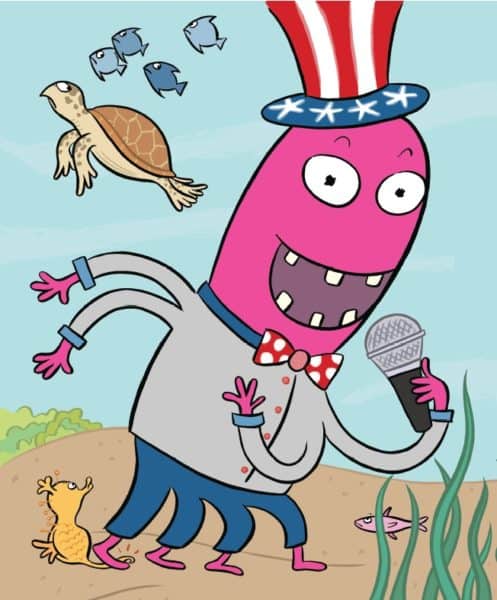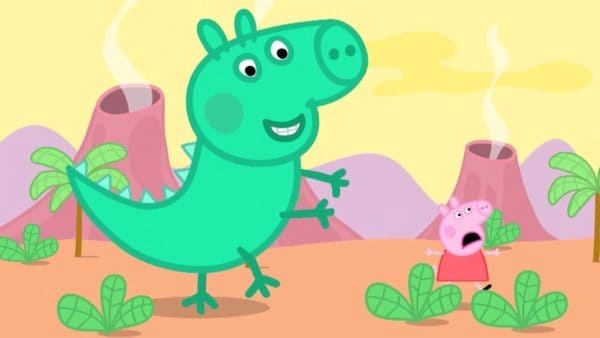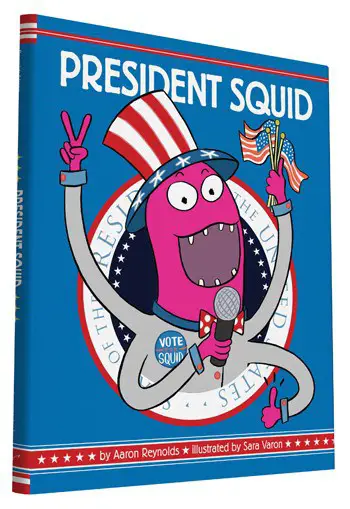The most hilarious thing about President Squid is that it is not about President Trump. Well, of course it’s about Trump and all of his kind, but as the author told Betsy Bird in an interview, it was already written and in the publishing pipeline before Trump even began his campaign. Reynolds wrote it around 2013/2014 with an election year book in mind.
Yet you can’t get a book that is MORE about President Trump.
But Aaron Reynolds is very clear in his intention for this book: A conversation starter about what it takes to be a good leader. Not a critique of anyone in particular.
How could he have predicted the future? This book is an excellent example of how the world changing around an author can cast a different light on your work of art… whether you meant it or not.
Reynolds is also keen to keep older readers, grades four and five, reading a lot of picture books. Betsy Bird agrees that the complexity of picture books tends to be higher than the early chapter books. Of course — chapter books are designed for emergent readers, who need help decoding the text. President Squid includes words like ‘unimpressed’, which may not make it into chapter books.
Reynolds has also noticed adults using this book as therapy for themselves, and believes it could easily be catalogued in the self-help section.
My own copy of President Squid was shipped second hand via Thriftbooks from a library in America. It’s a perfect, unread looking hardback copy with a big red stamp which reads ‘DISCARDED’. I have never in my life encountered this before. A brand new, perfect, library-bound children’s book from a popular, funny author… discarded. My hunch is that President Squid is considered too political for the children’s section of a public library and someone complained.
STORY STRUCTURE OF PRESIDENT SQUID
SHORTCOMING
Desire is connected to need: Squid needs to be taken seriously and to wield lots of power.
As you may have noticed, the story opens with a realisation:
I HAVE REALIZED SOMETHING VERY IMPORTANT. Something that changes everything! No giant squid has ever been president before!
Which means I will be the first.
President Squid!
Now that has a nice ring to it.
Of course, this is not to be mistaken for the Anagnorisis phase of the story. For starters, that comes in exactly the wrong place.
Don’t you love the ‘ring’ almost-pun? Squid rings… yum.
DESIRE
The desire-line in this book is super strong, which of course makes for a very strong story. In a funny book, hyperbole is king, and so a character who really, really wants something fits the comic tone.
Squid really wants to be president.
OPPONENT
After listing five reasons why he would make a most excellent president, Squid demands all hail and listen to him. But no one does. The fish just swim on past. This makes them his opponents.
PLAN
President Squid’s plan is to list all the reasons he would make a great president. They range from the frivolous to the grandiose. Interestingly, Reynolds lists five reasons, which is like the Rule of Threes only extended. Once he’s listed them, he recaps. He’s trying to persuade the reader as well as himself.
Then he seems to start out on his campaign, which involves going around demanding people listen to him.
BIG STRUGGLE
The Battle doubles as Squid’s Save The Cat Moment. (He saves a sardine from a clam.) The sardine tells him helping people is very presidential. This leads directly to Squid’s anagnorisis…
ANAGNORISIS
Hmm. Being president is more work than I thought.
(OMG, how can you read this and not think of Trump?)
There’s an unintended consequence for Squid, and an unexpected consequence for the reader: Because he helped somebody, everyone starts to think he’d make a great president after all.
Aaron Reynolds is super clear about story structure and underscores the Anagnorisis in case we missed it:
Wait!
I have realized something very important.
Being president is exhausting.
I do not want to be president.
NEW SITUATION
President Squid ends the same way The Pigeon Wants A Puppy ends (by Mo Willems). The capricious main character who suddenly decided he wanted one thing REAL BAD moves onto the next great love of his life.
Takeaway point: There’s nothing wrong with using the same gag, structured as other authors have structured it. It’s still really hard to come up with the content of that gag, and Aaron Reynolds comes up with the perfect new desire for Squid.
HUMOUR IN PRESIDENT SQUID
As you can see, Reynolds used classic story structure to tell a humorous tale. (This is not ‘comic structure’ — set up followed by gag.)
I am finding The Onion’s taxonomy of jokes incredibly useful when thinking about what makes picture books funny.
First we have IRONY: The reasons Squid gives for why he’d make a great president are a list of all the reasons why he WOULD NOT make a great president at all.
CHARACTER HUMOUR: This works even better when Squid is coded as Trump. Character humour is always better when you recognise ‘the sort of person’ being lampooned. The character humour in this picture book is therefore elevated to parody, and also satire.
HYPERBOLE: Basically essential in funny picture books. Squid doesn’t just want to be president of his class — he wants to be president of everything. Visually, he’s also the biggest squid of them all. When writing humour, exaggerate, exaggerate, exaggerate. Aaron Reynolds has also exaggerated the story structure itself. The desire is super strong (until it is suddenly, exaggeratedly, not); the anagnorisis arc is underscored. The reasons for being president are laid out clearly and then clearly stated again.
WORDPLAY HUMOUR: Squid uses the word ‘ring’ at the beginning and then at the end without even realising his (adult) audience (at least) thinks of him as food.
MADCAP: The crazy, wacky, silly, nonsensical aspect of humour has been given over to the illustrator, who has made the most of the many-handedness of a Squid. Varon has also exaggerated his body language.
MORE ON SARA VARON’S ILLUSTRATIONS
President Squid is illustrated in cartoony style, with outlines and flat colour fill. It can be difficult for an illustrator to stand out as unique with this kind of art, since it’s a pretty common, comic book style. But Varon’s illustrations do stand out as specifically hers.
- She’s used a pastelly palette for everything… except President Squid, who is chartreuse pink. If I’ve learnt one thing about colour it is this — an illustrator can use any palette they like, so long as it fits the story. The science of colour still applies, but once you know those rules, go ahead and break them as you see fit. It makes sense that Squid is lurid, against a background of normality. (Again, how can you not think of Trump’s tan?)
- Varon achieves aerial perspective by outlining foreground objects/characters in black, and background objects/characters in a darker shade of the main colour. You can see something similar done in Peppa Pig as well, though in Peppa Pig the foreground is outlined and the background not outlined at all. For more on how illustrators depict aerial perspective, see this post.


WRITE YOUR OWN
- The main character must really, really want the thing.
- The desire comes on suddenly after a false epiphany or encounter with the thing.
- The opposition is that the world does not want them to have this thing.
- The character basically lists reasons why they want this thing. That’s the main bulk of the story. These reasons are ironically wrong.
- The anagnorisis is that they don’t want that thing after all because they realise it is too much work. This character is inherently a shirker. The thing they have realised is true about that thing, in the real world.
- The joke is that they don’t realise something about themselves. Instead of taking a moment to reflect, they move on to the next totally inappropriate thing.

